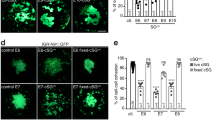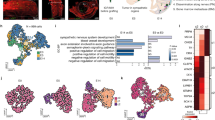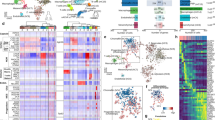Abstract
Previously, we observed expression of the homeobox transcription factor Prox1 in neuroectodermal embryonic tissues. Besides essential functions during embryonic development, Prox1 has been implicated in both progression and suppression of malignancies. Here, we show that Prox1 is expressed in embryonic sympathetic trunk ganglia of avian and murine embryos. Prox1 protein is localized in the nucleus of neurofilament-positive sympathetic neurons. Sympathetic progenitors represent the cell of origin of neuroblastoma (NB), the most frequent solid extracranial malignancy of children. NB may progress to life-threatening stage 4, or regress spontaneously in the special stage 4s. By qRT-PCR, we show that Prox1 is expressed at low levels in 24 human NB cell lines compared with human lymphatic endothelial cells (LECs), whereas equal immunostaining of nuclei can be seen in embryonic LECs and sympathetic neurons. In NB stages 1, 2, 3, and 4, we observed almost equal expression levels, but significantly higher amounts in stage 4s NB. By immunohistochemistry, we found variable amounts of Prox1 protein in nuclei of NB cells, showing intra and interindividual differences. Because stage 4s NB are susceptible to postnatal apoptosis, we assume that high Prox1 levels are critical for their behavior.
Similar content being viewed by others
Log in or create a free account to read this content
Gain free access to this article, as well as selected content from this journal and more on nature.com
or
Abbreviations
- ED:
-
embryonic day
- ISH:
-
in situ hybridization
- LEC:
-
lymphatic endothelial cell(s)
- NB:
-
neuroblastoma
- PFA:
-
paraformaldehyde
- PCNA:
-
proliferating cell nuclear antigene
- Prox1:
-
prospero-related homeobox transcription factor-1
- TH:
-
tyrosine hydroxylase
References
Oliver G, Sosa-Pineda B, Geisendorf S, Spana EP, Doe CQ, Gruss P 1993 Prox 1, a prospero-related homeobox gene expressed during mouse development. Mech Dev 44: 3–16
Rodriguez-Niedenfuhr M, Papoutsi M, Christ B, Nicolaides KH, von Kaisenberg CS, Tomarev SI, Wilting J 2001 Prox1 is a marker of ectodermal placodes, endodermal compartments, lymphatic endothelium and lymphangioblasts. Anat Embryol (Berl) 204: 399–406
Tomarev SI, Sundin O, Banerjee-Basu S, Duncan MK, Yang JM, Piatigorsky J 1996 Chicken homeobox gene Prox 1 related to Drosophila prospero is expressed in the developing lens and retina. Dev Dyn 206: 354–367
Wigle JT, Oliver G 1999 Prox1 function is required for the development of the murine lymphatic system. Cell 98: 769–778
Wilting J, Papoutsi M, Christ B, Nicolaides KH, von Kaisenberg CS, Borges J, Stark GB, Alitalo K, Tomarev SI, Niemeyer C, Rossler J 2002 The transcription factor Prox1 is a marker for lymphatic endothelial cells in normal and diseased human tissues. FASEB J 16: 1271–1273
Sosa-Pineda B, Wigle JT, Oliver G 2000 Hepatocyte migration during liver development requires Prox1. Nat Genet 25: 254–255
Wang J, Kilic G, Aydin M, Burke Z, Oliver G, Sosa-Pineda B 2005 Prox1 activity controls pancreas morphogenesis and participates in the production of “secondary transition” pancreatic endocrine cells. Dev Biol 286: 182–194
Wigle JT, Chowdhury K, Gruss P, Oliver G 1999 Prox1 function is crucial for mouse lens-fibre elongation. Nat Genet 21: 318–322
Risebro CA, Searles RG, Melville AA, Ehler E, Jina N, Shah S, Pallas J, Hubank M, Dillard M, Harvey NL, Schwartz RJ, Chien KR, Oliver G, Riley PR 2009 Prox1 maintains muscle structure and growth in the developing heart. Development 136: 495–505
Nagai H, Li Y, Hatano S, Toshihito O, Yuge M, Ito E, Utsumi M, Saito H, Kinoshita T 2003 Mutations and aberrant DNA methylation of the PROX1 gene in hematologic malignancies. Genes Chromosomes Cancer 38: 13–21
Takahashi M, Yoshimoto T, Shimoda M, Kono T, Koizumi M, Yazumi S, Shimada Y, Doi R, Chiba T, Kubo H 2006 Loss of function of the candidate tumor suppressor prox1 by RNA mutation in human cancer cells. Neoplasia 8: 1003–1010
Schneider M, Buchler P, Giese N, Giese T, Wilting J, Buchler MW, Friess H 2006 Role of lymphangiogenesis and lymphangiogenic factors during pancreatic cancer progression and lymphatic spread. Int J Oncol 28: 883–890
Shimoda M, Takahashi M, Yoshimoto T, Kono T, Ikai I, Kubo H 2006 A homeobox protein, prox1, is involved in the differentiation, proliferation, and prognosis in hepatocellular carcinoma. Clin Cancer Res 12: 6005–6011
Versmold B, Felsberg J, Mikeska T, Ehrentraut D, Kohler J, Hampl JA, Rohn G, Niederacher D, Betz B, Hellmich M, Pietsch T, Schmutzler RK, Waha A 2007 Epigenetic silencing of the candidate tumor suppressor gene PROX1 in sporadic breast cancer. Int J Cancer 121: 547–554
Petrova TV, Nykanen A, Norrmen C, Ivanov KI, Andersson LC, Haglund C, Puolakkainen P, Wempe F, von Melchner H, Gradwohl G, Vanharanta S, Aaltonen LA, Saharinen J, Gentile M, Clarke A, Taipale J, Oliver G, Alitalo K 2008 Transcription factor PROX1 induces colon cancer progression by promoting the transition from benign to highly dysplastic phenotype. Cancer Cell 13: 407–419
Wigle JT, Harvey N, Detmar M, Lagutina I, Grosveld G, Gunn MD, Jackson DG, Oliver G 2002 An essential role for Prox1 in the induction of the lymphatic endothelial cell phenotype. EMBO J 21: 1505–1513
Balla MM, Vemuganti GK, Kannabiran C, Honavar SG, Murthy R 2009 Phenotypic characterization of retinoblastoma for the presence of putative cancer stem-like cell markers by flow cytometry. Invest Ophthalmol Vis Sci 50: 1506–1514
Hamburger V, Hamilton H 1951 A series of normal stages in development of the chick embryo. J Morphol 88: 49–92
Buttler K, Kreysing A, von Kaisenberg CS, Schweigerer L, Gale N, Papoutsi M, Wilting J 2006 Mesenchymal cells with leukocyte and lymphendothelial characteristics in murine embryos. Dev Dyn 235: 1554–1562
Ziller C, Mirabel MA, Vandenbunder B, Fauquet M 1994 The tyrosine hydroxylase gene is expressed in endoderm and pancreas of early quail embryos. Anat Embryol (Berl) 189: 307–315
Jones PF, McClain J, Robinson DM, Sato TN, Yancopoulos GD 1998 Identification and characterisation of chicken cDNAs encoding the endothelial cell-specific receptor tyrosine kinase Tie2 and its ligands, the angiopoietins. Angiogenesis 2: 357–364
Becker J, Pavlakovic H, Ludewig F, Wilting F, Weich HA, Albuquerque R, Ambati J, Wilting J 2010 Neuroblastoma progression correlates with downregulation of the lymphangiogenesis inhibitor sVEGFR-2. Clin Cancer Res 16: 1431–1441
Pardanaud L, Altmann C, Kitos P, Dieterlen-Lievre F, Buck CA 1987 Vasculogenesis in the early quail blastodisc as studied with a monoclonal antibody recognizing endothelial cells. Development 100: 339–349
Wilting J, Buttler K, Schulte I, Papoutsi M, Schweigerer L, Manner J 2007 The proepicardium delivers hemangioblasts but not lymphangioblasts to the developing heart. Dev Biol 305: 451–459
Maris JM, Hogarty MD, Bagatell R, Cohn SL 2007 Neuroblastoma. Lancet 369: 2106–2120
Norgall S, Papoutsi M, Rossler J, Schweigerer L, Wilting J, Weich HA 2007 Elevated expression of VEGFR-3 in lymphatic endothelial cells from lymphangiomas. BMC Cancer 7: 105
Ciccarone V, Spengler BA, Meyers MB, Biedler JL, Ross RA 1989 Phenotypic diversification in human neuroblastoma cells: expression of distinct neural crest lineages. Cancer Res 49: 219–225
Dudas J, Mansuroglu T, Moriconi F, Haller F, Wilting J, Lorf T, Fuzesi L, Ramadori G 2008 Altered regulation of Prox1-gene-expression in liver tumors. BMC Cancer 8: 92
Schwarz Q, Maden CH, Vieira JM, Ruhrberg C 2009 Neuropilin 1 signaling guides neural crest cells to coordinate pathway choice with cell specification. Proc Natl Acad Sci USA 106: 6164–6169
Reissmann E, Ernsberger U, Francis-West PH, Rueger D, Brickell PM, Rohrer H 1996 Involvement of bone morphogenetic protein-4 and bone morphogenetic protein-7 in the differentiation of the adrenergic phenotype in developing sympathetic neurons. Development 122: 2079–2088
Shah NM, Groves AK, Anderson DJ 1996 Alternative neural crest cell fates are instructively promoted by TGFbeta superfamily members. Cell 85: 331–343
Howard MJ 2005 Mechanisms and perspectives on differentiation of autonomic neurons. Dev Biol 277: 271–286
Pistocchi A, Gaudenzi G, Carra S, Bresciani E, Del Giacco L, Cotelli F 2008 Crucial role of zebrafish prox1 in hypothalamic catecholaminergic neurons development. BMC Dev Biol 8: 27
Pritchard J, Hickman JA 1994 Why does stage 4s neuroblastoma regress spontaneously?. Lancet 344: 869–870
Westermann F, Schwab M 2002 Genetic parameters of neuroblastomas. Cancer Lett 184: 127–147
Brodeur GM, Pritchard J, Berthold F, Carlsen NL, Castel V, Castelberry RP, De Bernardi B, Evans AE, Favrot M, Hedborg F 1993 Revisions of the international criteria for neuroblastoma diagnosis, staging, and response to treatment. J Clin Oncol 11: 1466–1477
Castle VP, Heidelberger KP, Bromberg J, Ou X, Dole M, Nunez G 1993 Expression of the apoptosis-suppressing protein bcl-2, in neuroblastoma is associated with unfavorable histology and N-myc amplification. Am J Pathol 143: 1543–1550
Benard J, Raguenez G, Kauffmann A, Valent A, Ripoche H, Joulin V, Job B, Danglot G, Cantais S, Robert T, Terrier-Lacombe MJ, Chassevent A, Koscielny S, Fischer M, Berthold F, Lipinski M, Tursz T, Dessen P, Lazar V, Valteau-Couanet D 2008 MYCN-non-amplified metastatic neuroblastoma with good prognosis and spontaneous regression: a molecular portrait of stage 4S. Mol Oncol 2: 261–271
Nagai H, Kinoshita T, Suzuki H, Hatano S, Murate T, Saito H 1999 Identification and mapping of novel tumor suppressor loci on 6p in diffuse large B-cell non-Hodgkin's lymphoma. Genes Chromosomes Cancer 25: 277–283
Dudas J, Papoutsi M, Hecht M, Elmaouhoub A, Saile B, Christ B, Tomarev SI, von Kaisenberg CS, Schweigerer L, Ramadori G, Wilting J 2004 The homeobox transcription factor Prox1 is highly conserved in embryonic hepatoblasts and in adult and transformed hepatocytes, but is absent from bile duct epithelium. Anat Embryol (Berl) 208: 359–366
Chen X, Patel TP, Simirskii VI, Duncan MK 2008 PCNA interacts with Prox1 and represses its transcriptional activity. Mol Vis 14: 2076–2086
Papoutsi M, Dudas J, Becker J, Tripodi M, Opitz L, Ramadori G, Wilting J 2007 Gene regulation by homeobox transcription factor Prox1 in murine hepatoblasts. Cell Tissue Res 330: 209–220
Acknowledgements
We thank Mrs. S. Schwoch, Mrs. Ch. Zelent, Mr. B. Manshausen, Mr. M. Winkler, and Mr. F. Ludewig for their excellent technical assistance; and Drs. F. Berthold, B. Hero, and J. Theissen (German Neuroblastoma Studies Group, Children's Hospital University Cologne, Cologne, Germany) for providing tumor samples and data.
Author information
Authors and Affiliations
Corresponding author
Additional information
Supported by grant Wi1452/11-1 from Deutsche Forschungsgemeinschaft.
Rights and permissions
About this article
Cite this article
Becker, J., Wang, B., Pavlakovic, H. et al. Homeobox Transcription Factor Prox1 in Sympathetic Ganglia of Vertebrate Embryos: Correlation With Human Stage 4s Neuroblastoma. Pediatr Res 68, 112–117 (2010). https://doi.org/10.1203/PDR.0b013e3181e5bc0f
Received:
Accepted:
Issue date:
DOI: https://doi.org/10.1203/PDR.0b013e3181e5bc0f
This article is cited by
-
Temporal requirements for ISL1 in sympathetic neuron proliferation, differentiation, and diversification
Cell Death & Disease (2018)
-
Prox1 suppresses the proliferation of neuroblastoma cells via a dual action in p27-Kip1 and Cdc25A
Oncogene (2013)
-
Transcription factor PROX1: its role in development and cancer
Cancer and Metastasis Reviews (2012)
-
PROX1 lymphatic density correlates with adverse clinicopathological factors, lymph node metastases and survival in neuroblastomas
Journal of Neuro-Oncology (2012)
-
LYVE-1 upregulation and lymphatic invasion correlate with adverse prognostic factors and lymph node metastasis in neuroblastoma
Virchows Archiv (2012)



